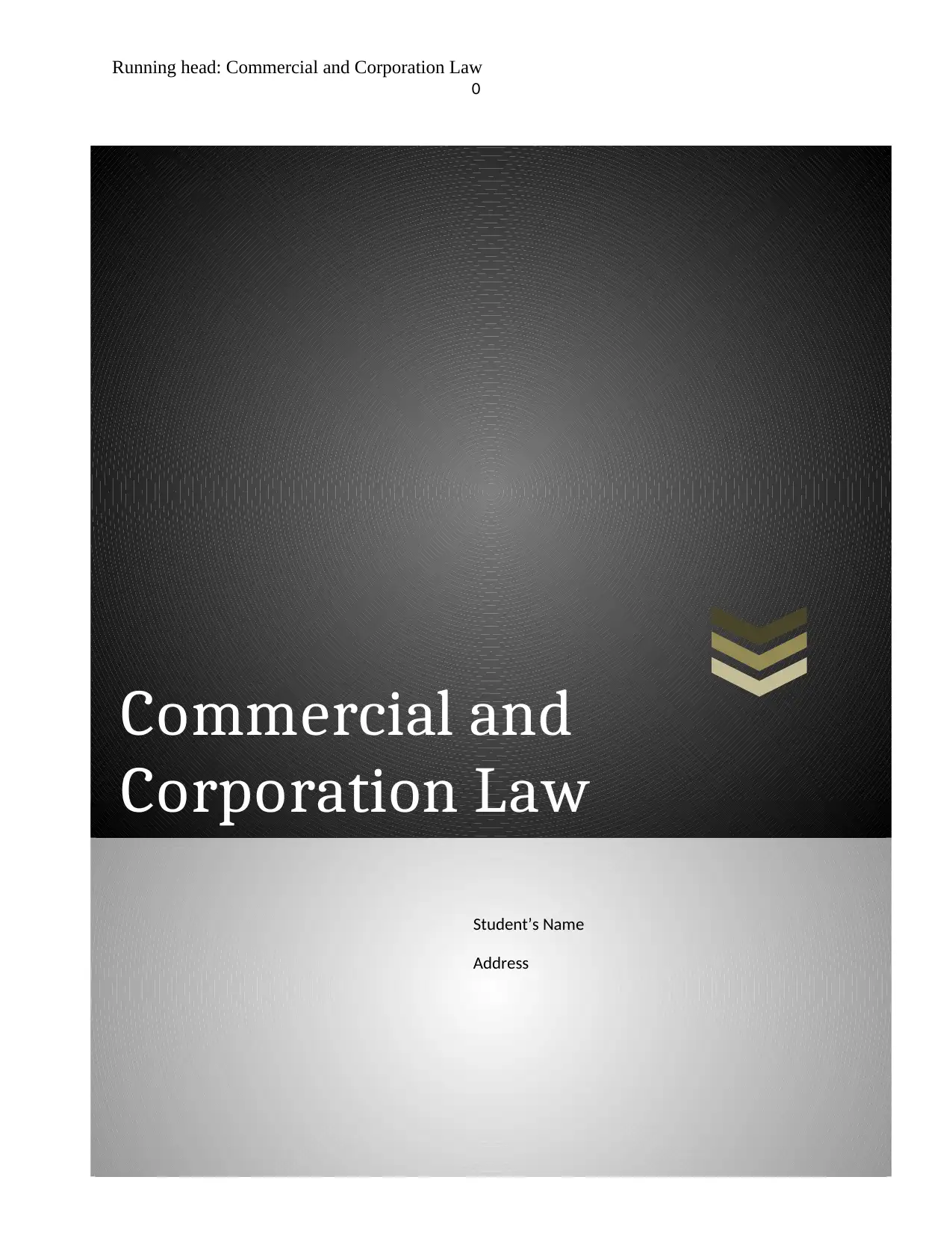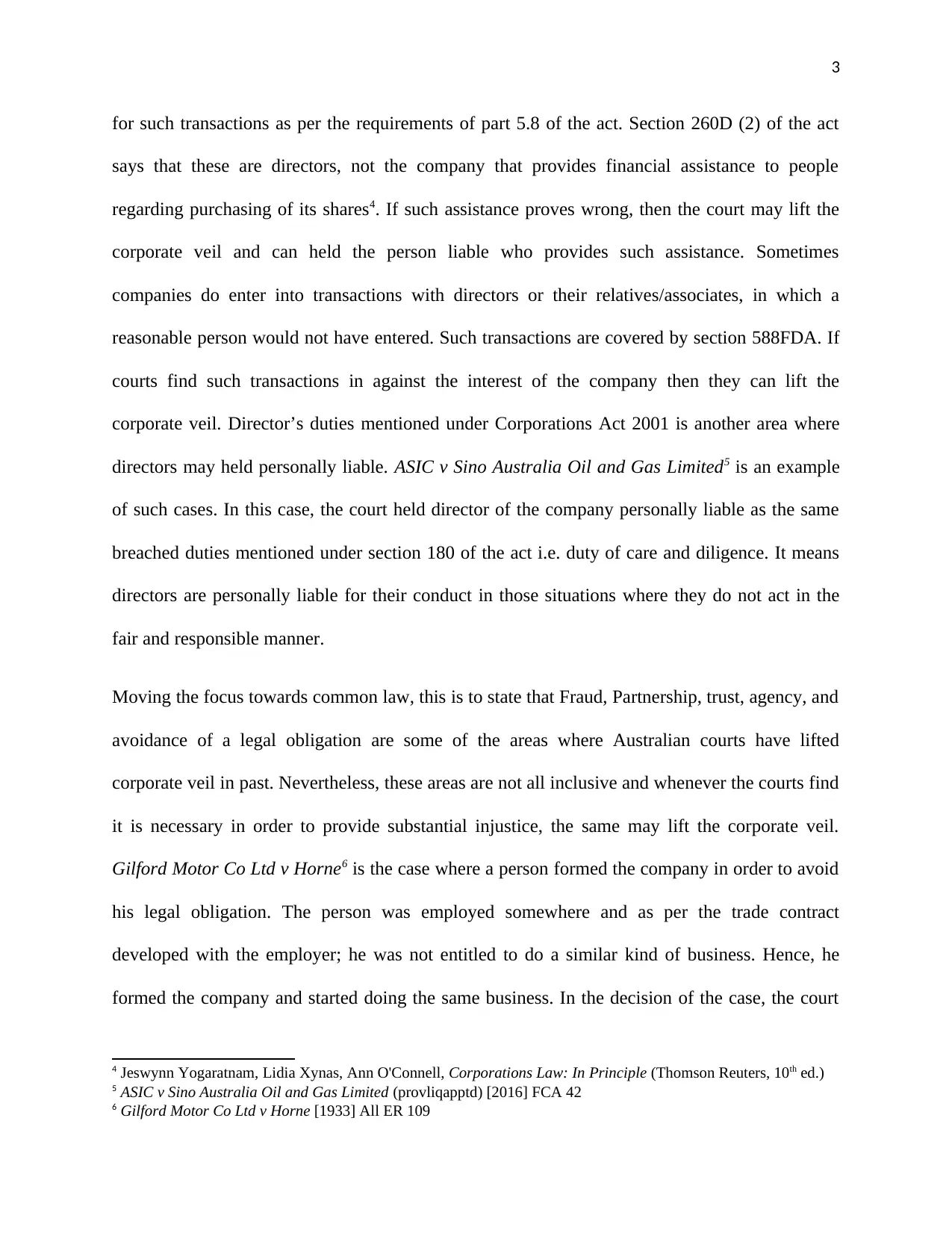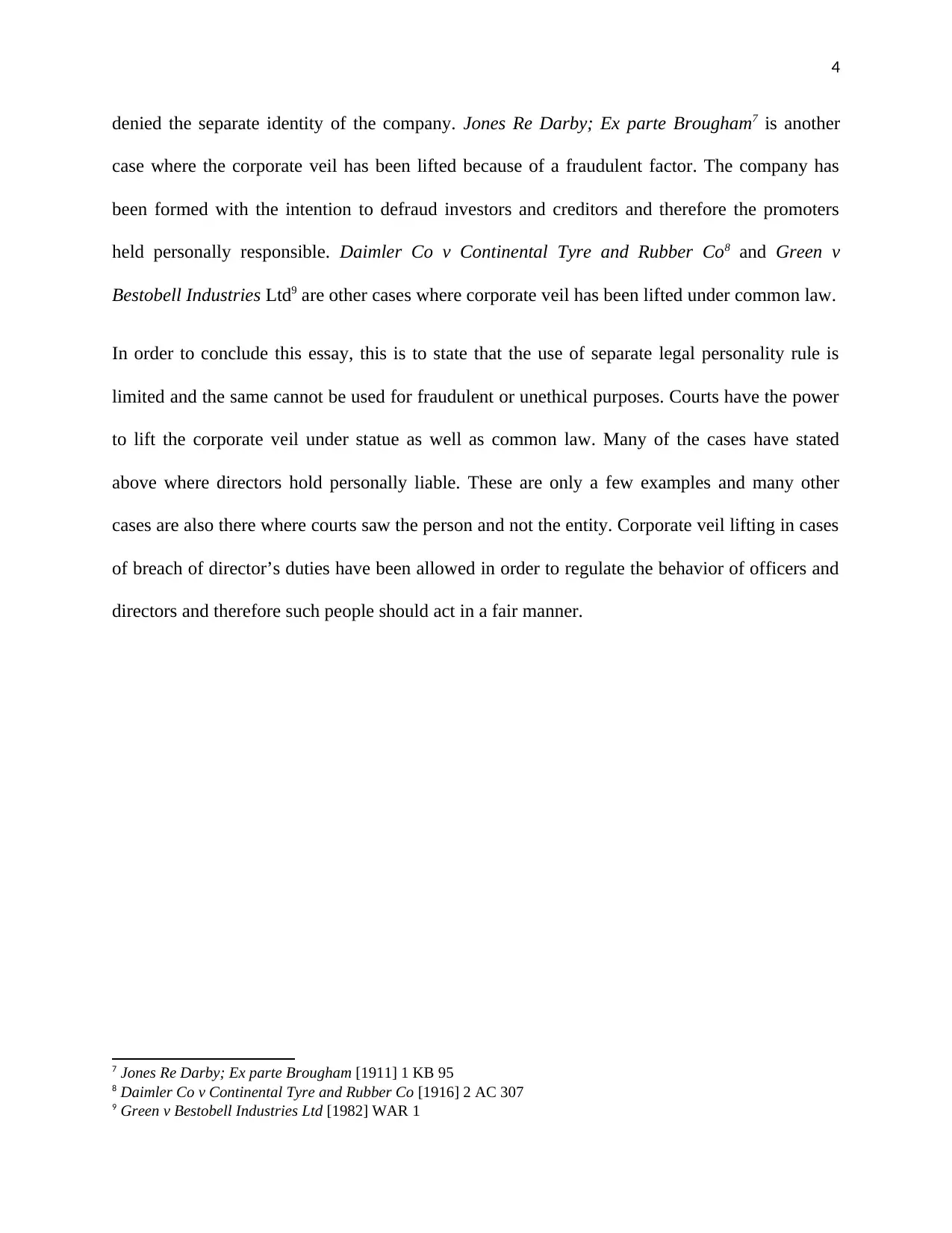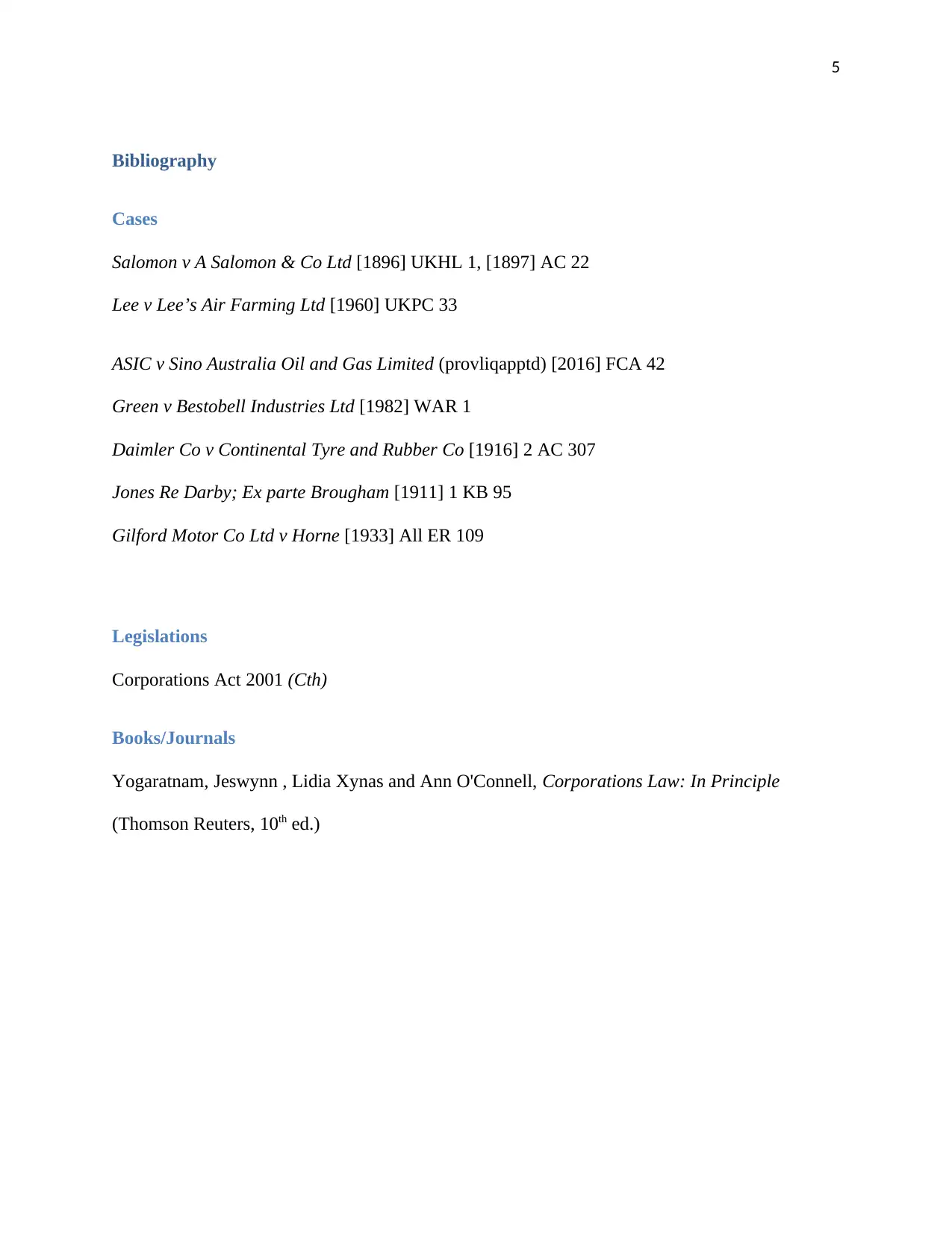Commercial and Corporation Law
VerifiedAdded on 2023/01/13
|6
|1628
|36
AI Summary
This article discusses the legal entity and separate legal personality of corporations in commercial and corporation law. It explains the concept of lifting the corporate veil and when directors can be held personally liable. The article also explores landmark cases and statutory provisions related to the topic.
Contribute Materials
Your contribution can guide someone’s learning journey. Share your
documents today.

Commercial and
Corporation Law
Running head: Commercial and Corporation Law
0
Student’s Name
Address
Corporation Law
Running head: Commercial and Corporation Law
0
Student’s Name
Address
Secure Best Marks with AI Grader
Need help grading? Try our AI Grader for instant feedback on your assignments.

1
Corporations are a legal entity. It means in the opinion of the law, this business structure has a
different legal identity. A corporation can do any commercial act similar to a natural person. The
same can enter into a transaction by its own name and can enter into a contract with a third party.
The third party in such a situation gets the same right they would have to get in against a natural
person. Further, a company can also sue another party by its name and similarly a third party can
sue a company. In a summaries way, this is to state that a corporation may conduct a whole
business alike an individual. Nevertheless, the same has certain limitations. As mentioned above
that a corporation is not an individual person, a corporation cannot perform its functions by its
own. Therefore, to perform the activities on behalf of the corporation, the board of directors is
there. These people are responsible to conduct all the business activities in the name of the
corporation. The important point to discuss here is that in addition to being a legal entity,
corporations are separate legal personality too. A company has a separate identity from its
members and directors/officers and the only company itself is liable for its conducts. In actual
these are directors and officers of the company who take decision for the company and perform
the transactions but they cannot be held liable for their conduct because of the separate legal
status of the company. In this manner, it will not be wrong to state that there is a virtual veil
between members/directors and company. This veil is known as the corporate veil.
Salomon v A Salomon & Co Ltd1 is the landmark case in which court accepted the presence of
the corporate veil. In the decision of this case, the court provides debenture rights to a person
who was the whole controller of the company and stated that no matter who is responsible to
control the business, a company will also be a separate person and nobody can be held liable for
the acts conducted in the name of the company. Similar kind of decision has been provided by
1 Salomon v A Salomon & Co Ltd [1896] UKHL 1, [1897] AC 22
Corporations are a legal entity. It means in the opinion of the law, this business structure has a
different legal identity. A corporation can do any commercial act similar to a natural person. The
same can enter into a transaction by its own name and can enter into a contract with a third party.
The third party in such a situation gets the same right they would have to get in against a natural
person. Further, a company can also sue another party by its name and similarly a third party can
sue a company. In a summaries way, this is to state that a corporation may conduct a whole
business alike an individual. Nevertheless, the same has certain limitations. As mentioned above
that a corporation is not an individual person, a corporation cannot perform its functions by its
own. Therefore, to perform the activities on behalf of the corporation, the board of directors is
there. These people are responsible to conduct all the business activities in the name of the
corporation. The important point to discuss here is that in addition to being a legal entity,
corporations are separate legal personality too. A company has a separate identity from its
members and directors/officers and the only company itself is liable for its conducts. In actual
these are directors and officers of the company who take decision for the company and perform
the transactions but they cannot be held liable for their conduct because of the separate legal
status of the company. In this manner, it will not be wrong to state that there is a virtual veil
between members/directors and company. This veil is known as the corporate veil.
Salomon v A Salomon & Co Ltd1 is the landmark case in which court accepted the presence of
the corporate veil. In the decision of this case, the court provides debenture rights to a person
who was the whole controller of the company and stated that no matter who is responsible to
control the business, a company will also be a separate person and nobody can be held liable for
the acts conducted in the name of the company. Similar kind of decision has been provided by
1 Salomon v A Salomon & Co Ltd [1896] UKHL 1, [1897] AC 22

2
the courts in the case of Lee v Lee’s Air Farming Ltd2. In this case, a person named Geoffrey Lee
formed a company in which he owned 2999 shares out of total 3000. He was the sole director
and was also working as chief pilot of the subjective company. On the event of his death in a
plane crash, his wife asked compensation under the Workers’ Compensation Act 1922. Privy
Council held the claim of his wife justified. It has been held that his husband was working as a
pilot and the company formed by him had separate legal status from him.
In many of the subsequent cases, people misused this virtual veil. They knew that they could not
be held liable for the acts done on behalf of the company. To prevent such cases, another rule
came into existence, which is termed as the lifting of the corporate veil. This rule says that the
court may held directors/members of the company personally liable in those cases where the
separate legal personality of the company been misused. Whenever courts lift the virtual veil, the
person behind the respective transactions becomes personally liable. Courts may lift this veil
under the provisions of the statue as well as under the virtue of common law. Firstly talking
about statutory provisions, this is to state that Corporations Act 20013 is applicable throughout
Australia. Provisions related to insolvent trading are one such area. When a company suspects to
be insolvent, the same should stop trade if the same does not have the capacity to repay debts.
However, sometimes companies keep its business carries on even when the same has no capacity
to repay the loan and there are enough reasonable grounds to suspect insolvency of the same.
Judges in such a situation have the right to lift the corporate veil and to held directors liable
under section 588G-588M. In addition to this, the court may also held members personally liable
under section 588V-588X. Further, when a company does the certain transaction in order to
defeat the entitlements of employees, the court may have company’s directors personally liable
2 Lee v Lee’s Air Farming Ltd [1960] UKPC 33
3 Corporations Act 2001 (Cth)
the courts in the case of Lee v Lee’s Air Farming Ltd2. In this case, a person named Geoffrey Lee
formed a company in which he owned 2999 shares out of total 3000. He was the sole director
and was also working as chief pilot of the subjective company. On the event of his death in a
plane crash, his wife asked compensation under the Workers’ Compensation Act 1922. Privy
Council held the claim of his wife justified. It has been held that his husband was working as a
pilot and the company formed by him had separate legal status from him.
In many of the subsequent cases, people misused this virtual veil. They knew that they could not
be held liable for the acts done on behalf of the company. To prevent such cases, another rule
came into existence, which is termed as the lifting of the corporate veil. This rule says that the
court may held directors/members of the company personally liable in those cases where the
separate legal personality of the company been misused. Whenever courts lift the virtual veil, the
person behind the respective transactions becomes personally liable. Courts may lift this veil
under the provisions of the statue as well as under the virtue of common law. Firstly talking
about statutory provisions, this is to state that Corporations Act 20013 is applicable throughout
Australia. Provisions related to insolvent trading are one such area. When a company suspects to
be insolvent, the same should stop trade if the same does not have the capacity to repay debts.
However, sometimes companies keep its business carries on even when the same has no capacity
to repay the loan and there are enough reasonable grounds to suspect insolvency of the same.
Judges in such a situation have the right to lift the corporate veil and to held directors liable
under section 588G-588M. In addition to this, the court may also held members personally liable
under section 588V-588X. Further, when a company does the certain transaction in order to
defeat the entitlements of employees, the court may have company’s directors personally liable
2 Lee v Lee’s Air Farming Ltd [1960] UKPC 33
3 Corporations Act 2001 (Cth)

3
for such transactions as per the requirements of part 5.8 of the act. Section 260D (2) of the act
says that these are directors, not the company that provides financial assistance to people
regarding purchasing of its shares4. If such assistance proves wrong, then the court may lift the
corporate veil and can held the person liable who provides such assistance. Sometimes
companies do enter into transactions with directors or their relatives/associates, in which a
reasonable person would not have entered. Such transactions are covered by section 588FDA. If
courts find such transactions in against the interest of the company then they can lift the
corporate veil. Director’s duties mentioned under Corporations Act 2001 is another area where
directors may held personally liable. ASIC v Sino Australia Oil and Gas Limited5 is an example
of such cases. In this case, the court held director of the company personally liable as the same
breached duties mentioned under section 180 of the act i.e. duty of care and diligence. It means
directors are personally liable for their conduct in those situations where they do not act in the
fair and responsible manner.
Moving the focus towards common law, this is to state that Fraud, Partnership, trust, agency, and
avoidance of a legal obligation are some of the areas where Australian courts have lifted
corporate veil in past. Nevertheless, these areas are not all inclusive and whenever the courts find
it is necessary in order to provide substantial injustice, the same may lift the corporate veil.
Gilford Motor Co Ltd v Horne6 is the case where a person formed the company in order to avoid
his legal obligation. The person was employed somewhere and as per the trade contract
developed with the employer; he was not entitled to do a similar kind of business. Hence, he
formed the company and started doing the same business. In the decision of the case, the court
4 Jeswynn Yogaratnam, Lidia Xynas, Ann O'Connell, Corporations Law: In Principle (Thomson Reuters, 10th ed.)
5 ASIC v Sino Australia Oil and Gas Limited (provliqapptd) [2016] FCA 42
6 Gilford Motor Co Ltd v Horne [1933] All ER 109
for such transactions as per the requirements of part 5.8 of the act. Section 260D (2) of the act
says that these are directors, not the company that provides financial assistance to people
regarding purchasing of its shares4. If such assistance proves wrong, then the court may lift the
corporate veil and can held the person liable who provides such assistance. Sometimes
companies do enter into transactions with directors or their relatives/associates, in which a
reasonable person would not have entered. Such transactions are covered by section 588FDA. If
courts find such transactions in against the interest of the company then they can lift the
corporate veil. Director’s duties mentioned under Corporations Act 2001 is another area where
directors may held personally liable. ASIC v Sino Australia Oil and Gas Limited5 is an example
of such cases. In this case, the court held director of the company personally liable as the same
breached duties mentioned under section 180 of the act i.e. duty of care and diligence. It means
directors are personally liable for their conduct in those situations where they do not act in the
fair and responsible manner.
Moving the focus towards common law, this is to state that Fraud, Partnership, trust, agency, and
avoidance of a legal obligation are some of the areas where Australian courts have lifted
corporate veil in past. Nevertheless, these areas are not all inclusive and whenever the courts find
it is necessary in order to provide substantial injustice, the same may lift the corporate veil.
Gilford Motor Co Ltd v Horne6 is the case where a person formed the company in order to avoid
his legal obligation. The person was employed somewhere and as per the trade contract
developed with the employer; he was not entitled to do a similar kind of business. Hence, he
formed the company and started doing the same business. In the decision of the case, the court
4 Jeswynn Yogaratnam, Lidia Xynas, Ann O'Connell, Corporations Law: In Principle (Thomson Reuters, 10th ed.)
5 ASIC v Sino Australia Oil and Gas Limited (provliqapptd) [2016] FCA 42
6 Gilford Motor Co Ltd v Horne [1933] All ER 109
Secure Best Marks with AI Grader
Need help grading? Try our AI Grader for instant feedback on your assignments.

4
denied the separate identity of the company. Jones Re Darby; Ex parte Brougham7 is another
case where the corporate veil has been lifted because of a fraudulent factor. The company has
been formed with the intention to defraud investors and creditors and therefore the promoters
held personally responsible. Daimler Co v Continental Tyre and Rubber Co8 and Green v
Bestobell Industries Ltd9 are other cases where corporate veil has been lifted under common law.
In order to conclude this essay, this is to state that the use of separate legal personality rule is
limited and the same cannot be used for fraudulent or unethical purposes. Courts have the power
to lift the corporate veil under statue as well as common law. Many of the cases have stated
above where directors hold personally liable. These are only a few examples and many other
cases are also there where courts saw the person and not the entity. Corporate veil lifting in cases
of breach of director’s duties have been allowed in order to regulate the behavior of officers and
directors and therefore such people should act in a fair manner.
7 Jones Re Darby; Ex parte Brougham [1911] 1 KB 95
8 Daimler Co v Continental Tyre and Rubber Co [1916] 2 AC 307
9 Green v Bestobell Industries Ltd [1982] WAR 1
denied the separate identity of the company. Jones Re Darby; Ex parte Brougham7 is another
case where the corporate veil has been lifted because of a fraudulent factor. The company has
been formed with the intention to defraud investors and creditors and therefore the promoters
held personally responsible. Daimler Co v Continental Tyre and Rubber Co8 and Green v
Bestobell Industries Ltd9 are other cases where corporate veil has been lifted under common law.
In order to conclude this essay, this is to state that the use of separate legal personality rule is
limited and the same cannot be used for fraudulent or unethical purposes. Courts have the power
to lift the corporate veil under statue as well as common law. Many of the cases have stated
above where directors hold personally liable. These are only a few examples and many other
cases are also there where courts saw the person and not the entity. Corporate veil lifting in cases
of breach of director’s duties have been allowed in order to regulate the behavior of officers and
directors and therefore such people should act in a fair manner.
7 Jones Re Darby; Ex parte Brougham [1911] 1 KB 95
8 Daimler Co v Continental Tyre and Rubber Co [1916] 2 AC 307
9 Green v Bestobell Industries Ltd [1982] WAR 1

5
Bibliography
Cases
Salomon v A Salomon & Co Ltd [1896] UKHL 1, [1897] AC 22
Lee v Lee’s Air Farming Ltd [1960] UKPC 33
ASIC v Sino Australia Oil and Gas Limited (provliqapptd) [2016] FCA 42
Green v Bestobell Industries Ltd [1982] WAR 1
Daimler Co v Continental Tyre and Rubber Co [1916] 2 AC 307
Jones Re Darby; Ex parte Brougham [1911] 1 KB 95
Gilford Motor Co Ltd v Horne [1933] All ER 109
Legislations
Corporations Act 2001 (Cth)
Books/Journals
Yogaratnam, Jeswynn , Lidia Xynas and Ann O'Connell, Corporations Law: In Principle
(Thomson Reuters, 10th ed.)
Bibliography
Cases
Salomon v A Salomon & Co Ltd [1896] UKHL 1, [1897] AC 22
Lee v Lee’s Air Farming Ltd [1960] UKPC 33
ASIC v Sino Australia Oil and Gas Limited (provliqapptd) [2016] FCA 42
Green v Bestobell Industries Ltd [1982] WAR 1
Daimler Co v Continental Tyre and Rubber Co [1916] 2 AC 307
Jones Re Darby; Ex parte Brougham [1911] 1 KB 95
Gilford Motor Co Ltd v Horne [1933] All ER 109
Legislations
Corporations Act 2001 (Cth)
Books/Journals
Yogaratnam, Jeswynn , Lidia Xynas and Ann O'Connell, Corporations Law: In Principle
(Thomson Reuters, 10th ed.)
1 out of 6
![[object Object]](/_next/static/media/star-bottom.7253800d.svg)





